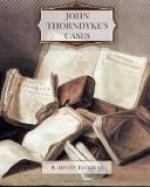“Then,” replied Thorndyke, “I must explain and demonstrate. To begin with, this projectile had to travel point foremost; therefore it had to be made to spin—and it certainly was spinning when it entered the body, as the clothing and the wound showed us. Now, to make it spin, it had to be fired from a rifled barrel; but as the hilt would not engage in the rifling, it had to be fitted with something that would. That something was evidently a soft metal washer, which fitted on to this hexagon, and which would be pressed into the grooves of the rifling, and so spin the dagger, but would drop off as soon as the weapon left the barrel. Here is such a washer, which Polton has made for us.”
He laid on the table a metal disc, with a hexagonal hole through it.
“This is all very ingenious,” said the inspector, “but I say it is impossible and fantastic.”
“It certainly sounds rather improbable,” Marchmont agreed.
“We will see,” said Thorndyke. “Here is a makeshift cartridge of Polton’s manufacture, containing an eighth charge of smokeless powder for a 20-bore gun.”
He fitted the washer on to the boss of the dagger in the open breech of the rifle, pushed it into the barrel, inserted the cartridge, and closed the breech. Then, opening the office-door, he displayed a target of padded strawboard against the wall.
“The length of the two rooms,” said he, “gives us a distance of thirty-two feet. Will you shut the windows, Jervis?”
I complied, and he then pointed the rifle at the target. There was a dull report—much less loud than I had expected—and when we looked at the target, we saw the dagger driven in up to its hilt at the margin of the bull’s-eye.
“You see,” said Thorndyke, laying down the rifle, “that the thing is practicable. Now for the evidence as to the actual occurrence. First, on the original dagger there are linear scratches which exactly correspond with the grooves of the rifling. Then there is the fact that the dagger was certainly spinning from left to right—in the direction of the rifling, that is—when it entered the body. And then there is this, which, as you heard, the porter found in the garden.”
He opened the paper packet. In it lay a metal disc, perforated by a hexagonal hole. Stepping into the office, he picked up from the floor the washer that he had put on the dagger, and laid it on the paper beside the other. The two discs were identical in size, and the margin of each was indented with identical markings, corresponding to the rifling of the barrel.
The inspector gazed at the two discs in silence for a while; then, looking up at Thorndyke, he said:
“I give in, Doctor. You’re right, beyond all doubt; but how you came to think of it beats me into fits. The only question now is, Who fired the gun, and why wasn’t the report heard?”




